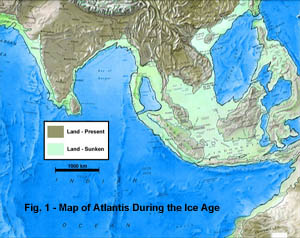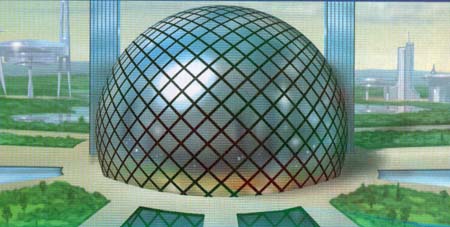EDUKATIF | Atlantis started with Plato and in his hands it was never a supercivilization of the sort conjectured by later authors; perhaps in strictly Greek terms it was no civilization at all but rather a fatally luxurious elaboration of an essentially barbarian way of life, for all its inception by a god. At all events, it was no seminal civilization: it wasn't the fons et origo of all later civilizations in the world, indeed Athens was its independent contemporary. Both Atlantis and old Athens were, for Plato, but episodes in the ever ongoing cycle of catastrophes and renewals that he saw as the most rational and scientific interpretation to which the world of human experience could be subjected. For him, science and religion were quite bound up together, so that the natural catastrophes were at the same time eras in which the divine light was withdrawn from the world and the equally natural renewals were times when it returned.
So rational and obviously true was this scheme of things to Plato that the "problem" of the real historical location and fate of Atlantis that has exercised so many writers after him would have left him cold, or perhaps amused to think of what he had started. We quoted early in this book several passages of Plato to show how he handled stories in his works.
Atlantis is the subject of a legend about an advanced island civilization that was destroyed or lost. Stories about Atlantis are first mentioned in Plato's dialogues Timaeus and Critias, in which characters say it was destroyed by an earthquake or a tsunami about 9,000 years before the time in which Plato wrote. The story claims Atlantis was somewhere outside the Pillars of Hercules. According to Plato, the story originated with Ancient Egyptian priests.
Some people believe that the stories are fictions made up to serve the purposes of Plato's dialogs. But others take them as if they were serious historical accounts.
There have been dozens — perhaps hundreds — of locations proposed for the classical Atlantis. Some are more-or-less serious attempts at legitimate scholarly or archaeological works; others have been made by psychic or other pseudoscientific means. As continental drift became better understood and accepted during the 1950s, most "Lost Continent" theories of Atlantis have been proven conclusively false.
Some cultures have "lost civilization" myths. In some cases, it has been argued that there is a common historical event or real "lost civilization" at the root of some or all of these legends, but there is considerable disagreement between the competing hypotheses. It may be that these legends have arisen from many different historical events, and are only just now being associated by modern theorizers because of their similarity. It may also be that these legends are entirely fictional, but for some reason have arisen and remained popular in many different cultures at different times.

However, anyone who inspects a chart of the oceanic bottoms in the region of Indonesia such as the Ice Age Map of Indonesia shown in Fig. 1 below, will readily concede that the South China Sea encircled by Indonesia indeed formed a continent during the last glaciation, which ended some 11,600 years ago. This chart clearly shows the sunken continent of Lemurian Atlantis in Indonesia, as well as the extensive sunken strip of Indian Atlantis at the Indus Delta.
The map leaves no room for doubt about the reality of what we are affirming concerning Lemurian and Indian Atlantis, one almost wholly sunken, and the other sunken to a very considerable extension. We remark that this map in contrast to most others presenting proposed sites for Atlantis and/or Lemuria is purely scientific, rather than an invention of ours or of others. It is based on the detailed geophysical reconstruction of the seabottoms in the region in question, and portrays the areas of depth under 100 meters, which were obviously exposed during the Ice Age, when sea level dropped by that amount and even more. 

In fact, several strictly scientific, similar maps exist, and can be seen elsewhere, inclusive in the Internet. One of these maps, was published in the National Geographic Magazine (vol.174, no.4, Oct. 1988, pg. 446-7) and is reproduced, for comparison, in Fig. 2 below. It shows the world as it was some 18,000 years ago, at the peak of the last glaciation of the Pleistocene Ice Age. As can be seen, this map corresponds quite closely with ours, shown in Fig. 1.
In particular, please note the huge chunk of land, of continental dimensions, to the south of Southeast Asia, and which became sunken when sea level rose, at the end of the Pleistocene. Another sizable piece of land in the Indus Delta, the site of the second Atlantis, also disappeared likewise, at that occasion. No other regions of the world display a similar event, including the Americas (not shown). The conclusion is that Atlantis, if Plato was in fact speaking truthfully, could only have been located in that region of the world.
As both maps above show, a huge extension of continental size prolonged Southeast Asia all the way down to Australia. This continental-sized land was indeed "larger than Asia [Minor] and Lybia [North Africa] put together", exactly as Plato affirms. It is seen to have been about two or three times larger than continental-sized India. It was also far larger than Australia, shown exagerated due to the peculiarities of the projection utilized.
The Indonesian Islands and the Malay Peninsula that we nowadays observe are the unsunken relicts of Lemurian Atlantis, the lofty volcanic mountains that became the volcanic islands of this region, the true site of Paradise in all ancient traditions. The sunken portion of continental extension now forms the muddy, shallow bottoms of the South China Sea.









.jpg)



